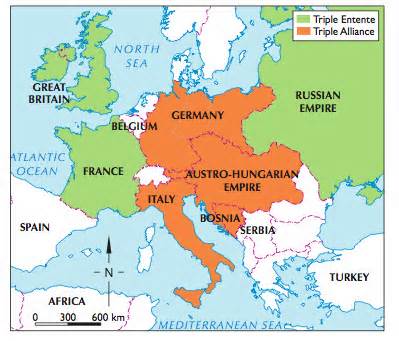The Triple Entente: Precursor to World War I
The Triple Entente was a diplomatic and military agreement between France, Great Britain, and Russia, formed in part as a response to the formation of the Triple Alliance.
In 1907, Great Britain and Russia reached an agreement on mutual self-defense (again with a mutual goal of containing an expanding Germany), and the two countries joined together with France to form the Triple Entente. As was the Triple Alliance, the Triple Entente was primarily a pact of mutual self-defense: Each country pledged to come to the military aid of another if that country were attacked. Thus it was that Russia, attacked by Austria-Hungary in 1914, called on Great Britain and France to enter the war. The beginning of full-scale war ended both the Triple Alliance and the Triple Entente, with the one caveat being that Italy, a member of the Triple Alliance, switched sides and joined the members of the Triple Entente on the battlefields fighting against Austria-Hungary, Bulgaria, Germany, and the Ottoman Empire. The beginning of war signalled the beginning of the end for the Triple Entente, but Russia's leaving the wary in 1917 certainly sealed the Triple Entente's fate. |
|
Social Studies for Kids
copyright 2002–2025
David White



 Russia had been part of the Three Emperors' League (with Austria-Hungary and Germany), but that union dissolved in the late 1880s, partly as a result of troubles in the Balkans. Russia formed the Dual Alliance with France, in 1894. A decade later, France formed an alliance with Great Britain called the Entente Cordiale. (Britain and France had a long history of disagreements and wars and were at that time involved in a struggle for supremacy in setting up colonies around the world, particularly in Africa; nonetheless, the two countries found common ground in opposing the expanding German Empire.)
Russia had been part of the Three Emperors' League (with Austria-Hungary and Germany), but that union dissolved in the late 1880s, partly as a result of troubles in the Balkans. Russia formed the Dual Alliance with France, in 1894. A decade later, France formed an alliance with Great Britain called the Entente Cordiale. (Britain and France had a long history of disagreements and wars and were at that time involved in a struggle for supremacy in setting up colonies around the world, particularly in Africa; nonetheless, the two countries found common ground in opposing the expanding German Empire.) 
